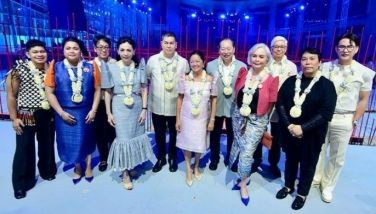Grass for furniture exports, fine dining and dwellings, too
July 21, 2002 | 12:00am
The world’s tallest grass – bamboo (Bambusa arudinacea) – has also the most number of benefits derived from it. Aside from the postcard pretty bahay kubo, bamboo together with rattan are the two main raw materials that make the country’s cottage industry exports a multi-billion dollar enterprise.
Moreover, this grass is excellent for reforestation, not to mention the livelihood and agribusiness opportunities it offers to uplanders, lowland farmers and agri-investors. Bamboo is a very versatile plant. Picture these: handicraft, furniture, construction materials for low-cost housing, poles for aquaculture, livestock housing, shades and fences and other household items, windbreaks, bird cages, banana props, rafts, fishing rods, fish traps and outriggers for bancas and fishpens.
Other than that, the young bamboo shoot (labong) is a vegetable for fine dishes cooked in coconut milk with seafoods (ginataan) and salad. Fresh bamboo shoots are found in the vegetable markets of Metro Manila. Markets for canned shoots are mostly in foreign countries, Japan especially.
Among the private sector’s bamboo enthusiasts is a lawyer-businessman who runs the Nepa-Q-Mart and the Nepa-Q-Mart Industries Bamboo Propagation and Dispersal Project (NQMI) along Edsa in Cubao – Atty. Nereo J. Paculdo. He maintains around 200 nurseries across the country which give away free seedlings and help farmers and entrepreneurs find buyers of their bamboo harvests. His seedling dispersal project started in 1988 and is still growing from strength to strength.
The dispersal scheme requires continuous interaction with NQMI to ensure that the recipients actually plant and nurture the seedlings to maturity, acquire essential know how of technologies for planting and propagation. More importantly, to make sure that the perpetuation and propagation, planting and production of bamboo on a wide scale and national basis is pursued.
"It is our way of reciprocating the favors we receive from the soil," enthuses Atty. Paculdo. "The Earth needs to be replanted and reforestated for the next generations from whom we merely borrow the blessings of nature. This is our little contribution, our labor of love."
Of the 30 endemic species in the Philippines, 19 are the erect type and the other 11 are of the climbing type:
Kawayang tinik (Bambusa blumeana); Kawayang kiling (Bambusa vulgaris); Kawayang dilaw (Bambusa vulgaris of the striata variety); Laac (B. philippinensis); Bayog (Dendrocalamus merillianus); Botong (Dendrocalamus latiflorus); Bolo (Gigantochloa levis); Higanteng kawayan (Gigantochloca aspera); Buho (Schizostachyum lumampao); and Anos (Schizostachym lima).
Kawayang tinik is considered the most important of the bamboo species because of its unlimited uses and wide distribution in the country. It is good for construction materials and its labong is a delicious table fare. This species is preferred over the others for its strength and durability. On the other hand, kawayang kiling is good for paper making.
Kawayang dilaw is a beautiful ornamental plant while botong and laac are used for propping banana plants in big plantations in Davao. Both are used as general construction materials. Bayog is known for its delicious bamboo shoots; when mature it is used mainly as a tying material (split into strands). It serves, also, as construction/furniture material and for sledge and cart in hauling farm produce.
A nipa hut can be built entirely of the bolo species – from the posts and stairs to the walls, floors and roof. This species is made into sawali, bambooply, particle board and specialty paper; it is good for general construction, too.
Grown for food – bamboo shoots preserved dried or canned – botong is commercially produced for export. Other than that, the culms or poles are used as general construction materials.
Higanteng kawayan, buho and anos are three other species of commercial value. The first is general construction materials for buildings and other structures like water conveyors and containers. Its thick wall and long internodes make it ideal for stringing tobacco leaves for drying.
The second is made into sawali,baskets and crates (for farm fresh vegetables and fruits), bamboo ply and specialty paper. It is also good for floor, wall and roof of bahay kubo, chicken house, pig pen and shed.
Moreover, this grass is excellent for reforestation, not to mention the livelihood and agribusiness opportunities it offers to uplanders, lowland farmers and agri-investors. Bamboo is a very versatile plant. Picture these: handicraft, furniture, construction materials for low-cost housing, poles for aquaculture, livestock housing, shades and fences and other household items, windbreaks, bird cages, banana props, rafts, fishing rods, fish traps and outriggers for bancas and fishpens.
Other than that, the young bamboo shoot (labong) is a vegetable for fine dishes cooked in coconut milk with seafoods (ginataan) and salad. Fresh bamboo shoots are found in the vegetable markets of Metro Manila. Markets for canned shoots are mostly in foreign countries, Japan especially.
Among the private sector’s bamboo enthusiasts is a lawyer-businessman who runs the Nepa-Q-Mart and the Nepa-Q-Mart Industries Bamboo Propagation and Dispersal Project (NQMI) along Edsa in Cubao – Atty. Nereo J. Paculdo. He maintains around 200 nurseries across the country which give away free seedlings and help farmers and entrepreneurs find buyers of their bamboo harvests. His seedling dispersal project started in 1988 and is still growing from strength to strength.
The dispersal scheme requires continuous interaction with NQMI to ensure that the recipients actually plant and nurture the seedlings to maturity, acquire essential know how of technologies for planting and propagation. More importantly, to make sure that the perpetuation and propagation, planting and production of bamboo on a wide scale and national basis is pursued.
"It is our way of reciprocating the favors we receive from the soil," enthuses Atty. Paculdo. "The Earth needs to be replanted and reforestated for the next generations from whom we merely borrow the blessings of nature. This is our little contribution, our labor of love."
Of the 30 endemic species in the Philippines, 19 are the erect type and the other 11 are of the climbing type:
Kawayang tinik (Bambusa blumeana); Kawayang kiling (Bambusa vulgaris); Kawayang dilaw (Bambusa vulgaris of the striata variety); Laac (B. philippinensis); Bayog (Dendrocalamus merillianus); Botong (Dendrocalamus latiflorus); Bolo (Gigantochloa levis); Higanteng kawayan (Gigantochloca aspera); Buho (Schizostachyum lumampao); and Anos (Schizostachym lima).
Kawayang tinik is considered the most important of the bamboo species because of its unlimited uses and wide distribution in the country. It is good for construction materials and its labong is a delicious table fare. This species is preferred over the others for its strength and durability. On the other hand, kawayang kiling is good for paper making.
Kawayang dilaw is a beautiful ornamental plant while botong and laac are used for propping banana plants in big plantations in Davao. Both are used as general construction materials. Bayog is known for its delicious bamboo shoots; when mature it is used mainly as a tying material (split into strands). It serves, also, as construction/furniture material and for sledge and cart in hauling farm produce.
A nipa hut can be built entirely of the bolo species – from the posts and stairs to the walls, floors and roof. This species is made into sawali, bambooply, particle board and specialty paper; it is good for general construction, too.
Grown for food – bamboo shoots preserved dried or canned – botong is commercially produced for export. Other than that, the culms or poles are used as general construction materials.
Higanteng kawayan, buho and anos are three other species of commercial value. The first is general construction materials for buildings and other structures like water conveyors and containers. Its thick wall and long internodes make it ideal for stringing tobacco leaves for drying.
The second is made into sawali,baskets and crates (for farm fresh vegetables and fruits), bamboo ply and specialty paper. It is also good for floor, wall and roof of bahay kubo, chicken house, pig pen and shed.
BrandSpace Articles
<
>
- Latest
Latest
Latest
March 4, 2024 - 3:32pm
By Ian Laqui | March 4, 2024 - 3:32pm
March 4, 2024 - 2:12pm
By Kristine Daguno-Bersamina | March 4, 2024 - 2:12pm
February 17, 2024 - 2:31pm
February 17, 2024 - 2:31pm
February 13, 2024 - 7:24pm
By Gaea Katreena Cabico | February 13, 2024 - 7:24pm
February 13, 2024 - 7:17pm
By Ian Laqui | February 13, 2024 - 7:17pm


























